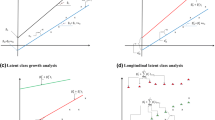Abstract
In this article, a conditional model is proposed for modeling longitudinal count data. The joint density is disintegrated into the marginal and conditional densities according to the multiplication rule. It allows both positive and negative correlation among variables, which most multivariate count models do not possess. To show the efficiency of the proposed model for count data, we have applied to the generalized estimating equations and the inverse Fisher information matrix is compared with the covariance matrix from estimating equations. A simulation experiment is displayed and an application of the model to divorce data is presented. In addition, a comparison of conditional model and bivariate Poisson model proposed by Kocherlakota and Kocherlakota has shown using simulated data.
Similar content being viewed by others
References
Agresti A (2002) Categorical data analysis, 2nd edn. Wiley, New York
Arnold BC (1987) Bivariate distributions with Pareto conditionals. Stat Probab Lett 5:263–266
Arnold BC, Strauss D (1988) Bivariate distributions with exponential conditionals. J Am Stat Assoc 83:522–527
Berkhout P, Plug E (2004) A bivariate Poisson count data model using conditional probabilities. StatisticaNeerlandica 58:349–364
Charalambides CHA, Papageorgiou H (1981) Bivariate Poisson binomial distributions. Biom J 28(5):437–450
Cordeiro GM, Rodrigues J, de Castro M (2012) The exponential COM-Poisson distribution. Stat Papers 53:653–664
Crowder M (1995) On the use of a working correlation matrix in using generalized linear models for repeated measures. Biometrika 82:407–410
Deshmukh SR, Kasture MS (2002) Bivariate distribution with truncated Poisson marginal distributions. Commun Stat Theory Methods 31(4):527–534
Diggle PJ, Heagerty P, Liang K-Y, Zeger SL (2002) Analysis of longitudinal data, 2nd edn. Oxford University Press, Oxford
Gourieroux C, Monfort A, Trognon A (1984) Pseudo maximum likelihood methods: theory. Econometrica 52:681–700
Health and Retirement Study (Wave [1-7]/Year [1992–2004]), Public use dataset, produced and distributed by the University of Michigan with funding from National Institute on Aging. Ann. Arbor, MI
Huang ML, Fung KY (1993) The D compound Poisson distribution. Stat Papers 34:319–338
Huang ML, Fung KY (1997) On moments and cumulants of the D compound Poisson distribution. Stat Papers 38:357–361
Joe H (1997) Multivariate models and dependence concepts. Chapman and Hall, London
Johnson NL, Kotz S (1969) Distributions in statistics: discrete distributions. Wiley, New York
Jung CJ, Winkelmann R (1993) Two aspects of labor mobility: a bivariate Poisson regression approach. Empir Econ 18:543–556
Jupp PE, Mardia KV (1980) A general correlation coefficient for directional data and related regression problems. Biometrika 67:163–173
Kocherlakota S, Kocherlakota K (2001) Regression in the bivariate Poisson distribution. Commun Stat Theory Methods 30(5):815–825
Kocherlatoka S, Kocherlakota K (1993) Bivariate discrete distributions. Marcel Dekker, New York
Liang K-Y, Zeger SL (1986) Longitudinal data analysis using generalized linear models. Biometrika 73:13–22
Lindsey JK, Lambert P (1998) On the appropriateness of marginal models for repeated measures in clinical trials. Stat Med 17:447–469
Masarotto G, Varin C (2012) Gaussian copula marginal regression. Electron J Stat 6:1517–1549
McCullagh P (1983) Quailikelihood function. Ann Stat 11:59–67
Mckenzie E (1988) Some ARMA models for dependent sequences of Poisson counts. Adv Appl Probab 20:822–835
Minka TP, Shmueli G, Kadane JB, Borle S, Boatwright P (2003) Computing with the COM- Poisson distribution. Technical report 776, Department of Statistics, Carnegie Mellon University. http://www.stat.cmu.edu/tr/tr776/tr776.html
Munkin MK, Trevedi PK (1999) Simulated maximum likelihood estimation of multivariate mixed-Poisson models with applications. Econom J 2:29–48
Nikoloulopoulos AK (2015) Efficient estimation of high-dimensional multivariate normal copula models with discrete spatial responses. Stoch Environ Res Risk Assess:1–13 doi:10.1007/s00477-015-1060-2
Nikoloulopoulos AK, Joe H, Chaganty NR (2011) Weighted scores method for regression models with dependent data. Biostatistics 12:653–665
Park Y, Oh CW (1997) Some asymptotic properties in INAR (1) processes with Poisson marginals. Stat Papers 38:287–302
Shmueli G, Minka TP, Kadane JB, Borle S, Boatwright P (2005) A useful distribution for fitting discrete data: revival of the Conway- Maxwell- Poisson distribution. Appl Stat 54:127–142
Song PX-K (2000) Multivariate dispersion models generated from Gaussian Copula. Scand J Stat 27:305–320
Sutradhar BC, Das K (1999) On the efficiency of regression estimator using generalized linear models for longitudinal data. Biometrika 86:459–465
Zimmer DM, Trivedi PK (2006) Using trivariate copulas to model sample selection and treatment effects. J Bus Econ Stat 24(1):63–76
Acknowledgments
We are grateful to the HRS (Health and Retirement Study) which is sponsored by the National Institute of Aging (Grant Number NIA U01AG09740) and conducted by the University of Michigan.
Author information
Authors and Affiliations
Corresponding author
Rights and permissions
About this article
Cite this article
Dey, R., Islam, M.A. A conditional count model for repeated count data and its application to GEE approach. Stat Papers 58, 485–504 (2017). https://doi.org/10.1007/s00362-015-0708-9
Received:
Revised:
Published:
Issue Date:
DOI: https://doi.org/10.1007/s00362-015-0708-9




